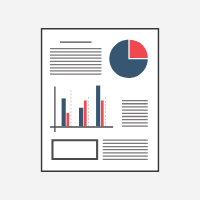I think you'll agree with me:
We want to invest in companies that are growing their customer base, investing in research and development, and expanding their workforce.
But how can a company grow without capital (i.e., money), and how does a company get capital without earnings growth?
The answer is either raising additional money from shareholders, or borrowing cash from a third-party.
As an investor you need to know which method a company is using to raise capital, and when it comes to understanding a company's capital there are no better measurement tools than leverage ratios.
Too much leverage is usually a bad sign for a company, but the right amount of leverage can lead to faster growth and greater shareholder value.
Today we'll cover the basics of leverage ratios, what they measure, and how you should be analyzing a company’s leverage to better understand their operations.
We’ll also break down three key ratios that evaluate a company’s leverage, and share a list of each leverage ratio, along with the formulas that you will need to calculate them.
What Are Leverage Ratios and What Do These Ratios Measure?
Leverage ratios are extremely important for fundamental investors to understand prior to investing in a stock.
These ratios measure how much capital a company is utilizing comes in the form of debt (loans), and also analyzes the ability of a company to meet its required debt payments.
When a company has a strong management team and they are deploying capital as efficiently and strategically as possible, debt can be used as a catalyst for growth.
Think about this in the context of your personal finances. If you are able to leverage your buying power and return on investment by borrowing money from a third-party, it can be smart to take out financing.
What might this look like?
Let’s say you are looking to buy a house, and you’ve saved up $200k that you’re planning to use to buy a home. You’re deciding between two homes. One costs $400k and the other costs $200k.
You don’t have the cash to buy the $400k home, but you could make it happen with a little help from your friends at the bank.
You do your research and find that the $400k home is selling way below its market value, and it’s in a growing area, so there’s a good chance the value of the home could go up after you buy!
What should you do?
Should you pass on the $400k home and buy the other house so you don’t need to take on debt?
I would say no. And here’s why:
By borrowing the $200k and buying the better house with better upside you now have leveraged the money you were planning to shell out for a down payment, and instead of having $200k invested, you now have a $400k investment, with no additional payment required on the day you buy the house.
Let’s say ten years down the road, both the $200k home and the $400k home had gone up in value at 5% per year and you’d been making annual interest-only payments on the $200k originally borrowed from the bank.
The market value of the $200k home would now be $296k (nice little $96k return there, not bad!), but the market value of the $400k home would be $592k!
Over that 10 year period you would have paid $88k in interest on the loan, so your total return on the $400k investment would have been $208k!
That’s $112k more than if you had avoided taking out the loan and bought the $200k house! The power of time and a compounding return never ceases to amaze!
So, what is the point of bringing in a personal finance story to our discussion on leverage ratios?
The point is, these ratios are an awesome tool for analyzing whether a Company is using debt effectively (like in this hypothetical personal finance story) and maximizing their return, or managing debt poorly and trying to play catch-up.
Not all debt is bad when it’s used effectively, and leverage ratios help us get a full story of whether a company has good debt or bad debt on its balance sheet.
Our goal is to find companies to invest in that are well position to pay off their debt and using that borrowed money to grow.
What we don’t want to see is a company that is spread too thin and heavily leveraged, where they are using debt as a bridge to make payments on other obligations.
Borrowing from one lender to pay another lender is not a trait of a well managed and well positioned company!
Analyzing these ratios is a key step in effective financial analysis and fundamental analysis.
Now that our understanding of the overall principle of these ratios is clear, we can start looking at the different types of ratios and their formulas.
Types of Leverage Ratios and The Formulas You need to Calculate Them
There are three main ratios that measure how a company is leveraged and whether that company has the ability to pay its debt obligations.
We’ll start with taking a look at the debt ratio.
Debt Ratio
The debt ratio is calculated by taking a company’s total debt, and dividing it by the company’s total assets.
Debt Ratio = Total Debt / Total Assets
The debt ratio is used to analyze how much of the company’s assets are financed through short-term and long-term debt.
The higher a company’s debt ratio, the more leveraged that company is, which would imply they are exposed to greater financial risk. If a company has no outstanding loans, their debt ratio would be zero, which would tell you that the company’s assets are not tied to any financing arrangements, and the assets are owned free-and-clear by the Company.
This can definitely be a strength signal of company; however, as we discussed earlier, leverage isn’t all bad.
Your interpretation of a company’s debt ratio should consider whether the ratio is indicating that a company is over-leveraged, and if so, how are the other fundamentals of the company? Do the profitability ratios indicate that in fact the company is growing rapidly, margins are strong, and management is effectively controlling costs to develop a strong bottom line?
If so, that could be an indicator that the company is appropriately taking on debt and re-deploying the extra capital to facilitate growth and keep up with demand.
Let’s look at an example to better understand the debt ratio. Apple, Inc. (AAPL) reported total debt of $115,680 and total assets of $375,319 (in millions) as of September 30, 2017. The calculated debt ratio was about 31% at that date.
Does this indicate Apple is cash strapped, and taking on unnecessary debt, or that Apple is effectively utilizing debt to grow and expand their business?
We’d need to do a bit more analysis to know for sure, but my guess would be the latter.
Looking at the rest of the Company’s balance sheet shows that there aren’t any big red flags in their liquidity ratios, and profitability ratios were strong during the period as well.
Obviously, much more detailed analysis would be required before we would be comfortable investing in Apple, but based on the quick information we looked at, perhaps 31% isn’t so bad?
Alright, let’s press on to another ratio that measures a company’s long-term debt relative to its equity.
Debt to Equity Ratio
The debt to equity ratio is calculated by taking a company’s total debt and dividing that by the company’s total equity.
Debt to Equity Ratio = Total Debt / Total Equity
As you can see, this ratio focuses on the different types of financing (debt and equity), which allows us to analyze how a company is currently leveraged.
If a company’s debt to equity ratio is high, this would be an indicator that they are utilizing more outside financing as capital to run the business. In this situation it will be important to analyze how the company is using the debt to assess the overall health of the company.
When a company is using a lot of debt to finance its operations (high debt to equity), this could be an advantage to shareholders if the company is generating more earnings from the borrowed funds than it would have without the third-party financing.
If this increase in earnings is greater than the cost to borrow the money (i.e., interest paid on the outstanding balance, bank fees, etc…), then the shareholders would benefit from the increased earnings.
However, as I’m sure you can guess, if the cost to borrow the money is outpacing the increased earnings generated from the borrowed funds, the shareholders value in the company would take a hit.
Evaluating a company’s debt to equity ratio will give you a good idea of how a company is leveraged.
As investors, we only want to see a higher debt to equity ratio if we are also reaping the benefits of increased earnings from the leveraged funds.
Interest Coverage Ratio
Alright, we have arrived at our third and final leverage ratio that we’ll be diving into today and it’s a big one, the interest coverage ratio.
The interest coverage ratio is calculated by dividing earnings before interest and taxes (EBIT), by a company’s interest expense.
Interest Coverage Ratio = EBIT / Interest Expense
The interest coverage ratio measures a company’s ability, and cushion, to make interest payments on their outstanding debt.
It essentially tells us how many times the company could pay the interest on its current loans with its current earnings.
This ratio is important because it gives us a better understanding of how much of the company’s current earnings are going towards making payments on interest.
Ideally, we want this number to be as low as possible, which would indicate that a company has a good chunk of their earnings available after making interest payments to re-invest that money and grow the business.
The interest coverage ratio also gives us a better understanding of whether a company is growing earnings through the use of debt, or if the interest expense on the company’s loans is outpacing the additional earnings generated from the borrowed funds.
To demonstrate, lets say a company had interest expense of $400k on $10,000,000 in loans during fiscal year 2018. During the period that same company had EBIT of $600k, which would pencil out to an interest coverage ratio of 1.5.
Generally, if a company’s interest coverage ratio is 1.5 or lower, it’s starting to look a little dicey on whether they will be able to meet interest expense demand going forward. Anything less than 1.5 is usually an indicator that tough times are ahead, as bank’s will likely refuse to lend the company any more cash, and the risk of default would be high.
But, let’s give this imaginary company’s management team some credit.
They believe in their product, and although they paid a high portion of their earnings to their lenders in 2018 for interest expense, they are confident that the reinvestment of the borrowed money will pay off going forward, which will result in some big time earnings growth over the next 10 years.
Sure enough, the management team was right, and for the next 10 years earnings grew at a rate of 15% year-over-year. They didn’t borrow any more cash and continued making interest-only payments on the $10,000,000 loan at an interest rate of 4%.
Check out the table below.
| Year | Interest Expense | EBIT | Interest Coverage Ratio |
|---|---|---|---|
| 2018 | 400,000 | 600,000 | 1.50 |
| 2019 | 400,000 | 690,000 | 1.73 |
| 2020 | 400,000 | 793,500 | 1.98 |
| 2021 | 400,000 | 912,525 | 2.28 |
| 2022 | 400,000 | 1,049,404 | 2.62 |
| 2023 | 400,000 | 1,206,814 | 3.02 |
| 2024 | 400,000 | 1,387,836 | 3.47 |
| 2025 | 400,000 | 1,596,012 | 3.99 |
| 2026 | 400,000 | 1,835,414 | 4.59 |
| 2027 | 400,000 | 2,110,726 | 5.28 |
| 2028 | 400,000 | 2,427,335 | 6.07 |
Boom! Over that 10 year period, the company continued paying the $400k in interest, but once the company’s investment of the borrowed funds took hold, and started to ramp up earnings, the Company’s EBIT increased significantly, and so did their interest coverage ratio.
As you can see, evaluating the trends of a company’s historical interest coverage ratio can give you some insight into how a company manages its debt, and if they are effectively using debt to ramp up earnings.
That’s it!
We’ve ran through three important ratios that seasoned investors use to calculate how well a company is managing their debt.
Now it’s time to take a look at a few more ratios that measure a company’s leverage.
Complete List of Leverage Ratios and Formulas
We’ve summarized the remaining ratios that you'll need to analyze a company's leverage below (including the ones we covered above), so you have a complete list of ratios and formulas to refer back to when you are knee deep in your fundamental analysis.
| Leverage Ratios | Formula |
|---|---|
| Debt Ratio | Total Debt / Total Assets |
| Debt to Equity | Total Debt / Total Equity |
| Interest Coverage Ratio | EBIT / Interest Expense |
| Equity Ratio | Total Equity / Total Assets |
| Debt to Capital | Total Debt / (Total Debt + Total Equity) |
| Debt to EBITDA | Total Debt / Earnings Before Interest Taxes Depreciation & Amortization (EBITDA) |
| Assets to Equity | Total Assets / Total Equity |
These ratios will give you a good idea of whether a company is well leveraged, and whether they will be able to pay their required interest payments on the loans going forward.
The Power of Leverage Ratios in Your Stock Analysis
Leverage ratios are a key piece of the overall fundamental analysis puzzle.
If a company's ratios indicate they aren’t generating enough increased earnings to warrant the cost of the additional debt, or that the company is too leveraged, this could be an indicator that the company will struggle to reinvest the borrowed cash to deliver a high return to shareholders.
When looking for stocks that provide a higher return and lower risk, we want to invest in company’s that are effectively using debt to grow, rather than companies that are anchored down by debt and the interest payments on that debt.
Leverage can be a powerful tool for companies to grow a business, but it can also be a roadblock to growth, and eventually a companies downfall if it isn’t managed correctly.
If you're interested in finding stocks with optimal leverage ratios, check out our article that walks through the process of using a value stock screener to identify investment ideas.








